1、 Teigha 中 DWG 数据库结构:
经 常 用 到 的 有 TextStyleTable 、 LayerTable 、 LinetypeTable 、 BlockTable 及 其 对 应 的
TextStyleTableRecord 、LayerTableRecord、LinetypeTableRecord 、BlockTableRecord 及 Entity 。
2、具体使用
2.1 添加引用
使用前应该添加 TD_Mgd_3.03_9.dll 或是其他版本类库, 类库分为 64 位与 32 位,32 位类库
在 64 位系统上运行效果可能不太好。 3.02 版本及一下版本可能没有 64 位的类库。
命名空间有:
Teigha.DatabaseServices;
Teigha.Geometry;
Teigha.Colors;
Teigha.Export_Import;
Teigha.GraphicsInterface;
Teigha.GraphicsSystem;
Teigha.Runtime;
3.02 及以下版本命名空间应将 Teigha 换为 DWGdirect 。
�
2.2 打开、新建、保存数据库
使用之前应加上这个:
using ( Services ser = new Services ())// 一个应用程序加上一个就行了,否则出错
1、打开数据库( dwg 文件)
using ( Database pDb = new Database( false , false ))// 不加参数会出错
{
pDb.ReadDwgFile(
Application
.StartupPath
+
"\\TABMENU.dwg",
FileOpenMode.OpenForReadAndWriteNoShare,
false , "" );
}
2、新建数据库
using ( Database pDb = new Database())// 加参数出错
3、保存
(1)保存格式
SaveType pSavetype = SaveType.Save12;
默认保存为 dwg ,可以不用指定。
(2)保存版本类型
DwgVersion dwgver = DwgVersion.vAC18;
vAC18;
很重要,保存时要用,版本过高时低版本
(3)保存
pDb.SaveAs(filename, dwgver);
//Save12 为.dwg Save13 为dxf
//ACAD2010为 vAC24; ACAD2007为 vAC21; ACAD2004为
AutoCAD 不能打开。
pDb 为数据库( Database), filename 为 dwg 文件名, dwgver 为版本。
2.3 写数据
2.3.1 添加文本样式
ObjectId styleId =
ObjectId .Null;
using ( TextStyleTable pStyles =
( TextStyleTable )pDb.TextStyleTableId.GetObject(
OpenMode.ForWrite))
{
{
// 文本样式记录
using ( TextStyleTableRecord pStyle =
new TextStyleTableRecord ())
// 表对象(记录)添加到表之前必须命名
//
flag must also be set (if
isShapeFile
true) before adding the object
�
pStyle.Name = styleName;
// 必须设定
// to the database.
pStyle.IsShapeFile = isShapeFile;
// 添加(记录)到数据库之前必须设定
(如果为 true )
styleId = pStyles.Add(pStyle);
// Add the object to the table.
添加对象(记录)到表
// 设置剩下的属性。 (可以添加后设置也可以添加之前设置)
pStyle.TextSize = textSize;
pStyle.XScale = xScale;
pStyle.PriorSize = priorSize;
pStyle.ObliquingAngle = obliquing;
pStyle.FileName = fileName;
(isShapeFile)
pStyle.PriorSize = 22.45;
if
pStyle.Font
= newFontDescriptor
(ttFaceName, bold,
italic,
charset,
if
(! string .IsNullOrEmpty(ttFaceName))
pitchAndFamily);
return styleId;
}
}
注: pDb 为 Database
2.3.2 添加线型
using ( LinetypeTable pLinetypes =
( LinetypeTable )pDb.LinetypeTableId.GetObject(
OpenMode.ForWrite))
{
{
// 线表记录
using ( LinetypeTableRecord pLinetype =
new LinetypeTableRecord ())
pLinetype.Name = name;
// 必须命名
ObjectId linetypeId = pLinetypes.Add(pLinetype);
// 添加记录
return linetypeId;
}
}
�
注:线型要有相应的线型文件,且不一定能够加成功,线型可以在使用之前手动加在
模板中,从其他文件向 dwg 文件复制线型,可能不成功。
dwg
2.3.3 添加块
例:
using ( BlockTable blockTable = ( BlockTable )pDb.BlockTableId.GetObject(
OpenMode.ForWrite))
{
{
ObjectId annoBlockId;
using ( BlockTableRecord btr =
new BlockTableRecord ())
btr.Name =
annoBlockId = blockTable.Add(btr);
"AnnoBlock" ;
using ( Circle pCircle =
new Circle ())
{
pCircle.SetDatabaseDefaults(pDb);
btr.AppendEntity(pCircle);
Point3d center =
new Point3d (0, 0, 0);
pCircle.Center = center;
pCircle.Radius = 0.5;
}
}
}
向块表中加入块之前, 块一定要有名字。 同时可以从其他文件中提取块, 加入到目标数据库
中
例:
using ( Database db = new Database( false , false ))
{
".dwg" ))
{
}
if
(! File .Exists( Application .StartupPath +
"\\BLOCKS\\" + blockname +
MessageBox.Show(" 没找到 CASS块文件 " );
return ObjectId .Null;
db.ReadDwgFile(
Application .StartupPath + "\\BLOCKS\\" + blockname + ".dwg" ,
FileOpenMode.OpenForReadAndAllShare,
false , "" );
using ( BlockTable pTable =
( BlockTable )db.BlockTableId.Open( OpenMode.ForRead))
{
( BlockTable )pDb.BlockTableId.Open( OpenMode.ForWrite))
using ( BlockTable bt =
{
�
using ( BlockTableRecord btr =
new BlockTableRecord ())
{
{
foreach ( ObjectId id
in pTable)
using ( BlockTableRecord pBlock =
( BlockTableRecord )id.Open( OpenMode.ForRead))
{
{
foreach ( ObjectId entid
in pBlock)
using ( Entity pEnt =
( Entity )entid.Open( OpenMode.ForRead,
{
false , true ))
btr.AppendEntity((
Entity )pEnt.Clone());
}
}
}
}
btr.Name = blockname;
ObjectId blockid = bt.Add(btr);
return blockid;
}
}
}
}
2.3.4 向模型( model)空间画实体(线、面等)
加入线,例:
using ( BlockTable blockTable = ( BlockTable )pDb.BlockTableId.GetObject(
OpenMode.ForWrite))
{
ObjectId modelSpaceID = blockTable[
BlockTableRecord .ModelSpace];
using ( BlockTableRecord btr =
( BlockTableRecord )modelSpaceID.GetObject( OpenMode.ForWrite))
{
{
using ( Polyline2d pline =
new Polyline2d ())
btr.AppendEntity(pline);//
向块记录中添加线
Vertex2d pVertex =
Point3d pos = start;//
new Vertex2d ();// 顶点
起点
pVertex =
new Vertex2d ();
pline.AppendVertex(pVertex);
�
pos = start;//
pVertex.Position = pos;
起点
pVertex.Dispose();
pVertex =
new Vertex2d ();
pline.AppendVertex(pVertex);
pos = end;//
顶点,终点
pVertex.Position = pos;
if
(linewidth >= 0.0)
{
pVertex.StartWidth = linewidth;
pVertex.EndWidth = linewidth;
}
pVertex.Dispose();
// 线宽
//pline.Closed
(linestyle !=
if
= false;// 此属性在画线时不加, 但在成面时将属性变为 true
null
)
{
pline.Linetype = linestyle;//
}
线型
pline.Layer = LayerName;//
图层名
}
}
}
}
加入面的操作与上面加入线类似,但最后线的
Closed 属性应设置成 true。
插入文字:
using ( BlockTableRecord bBTR =
( BlockTableRecord )modelSpaceID.GetObject( OpenMode.ForWrite))
{
{
using ( DBText pText = new DBText())
// 开始时插入文字以左上点为准插入
using ( Database pDb = bBTR.Database)
pText.SetDatabaseDefaults(pDb);
ObjectId textId = bBTR.AppendEntity(pText);
// 注释
pText.Annotative =
AnnotativeStates
.True;
// 加入到特殊群
if
(pGroup !=
null )
pGroup.Append(textId);
�
pText.Position = position;
// 位置(应该是左上方)
pText.AlignmentPoint = alignmentPoint;
// 校准点什么东西
pText.Height = height;
pText.WidthFactor = 1.0;
pText.TextString = text;
// 高度
// 什么东西
pText.HorizontalMode = hMode;
pText.VerticalMode = vMode;
pText.Oblique = OdaToRadian(oblique);
pText.Rotation = OdaToRadian(rotation);
// 文字模式
// 垂直模式
// 倾斜
// 旋转
// 文字样式
if
(!textstyleID.IsNull)
pText.TextStyleId = textstyleID;
// 层名
if
(!layerId.IsNull)
pText.SetLayerId(layerId,
false );
{
if
(widthfactor != 0.0)
pText.WidthFactor = widthfactor;//
宽度因子
}
}
}
插入块:
using ( BlockTableRecord btr =
( BlockTableRecord )modelSpaceID.GetObject( OpenMode.ForWrite))
{
BlockReference pBlkRef = new BlockReference (point, btr.ObjectId);//point
为插入的位置
pBlkRef.BlockTableRecord = BlockRefID;//
块在数据库中的 id
pBlkRef.ScaleFactors =
pBlkRef.LayerId = layerID;//
btr.AppendEntity(pBlkRef);//
new Scale3d (scale, scale, scale);//
比例
图层 id
插入块
}
2.3.5 图层
加入图层:
using ( LayerTable pLayers = (
{
LayerTable )pDb.LayerTableId.GetObject(
OpenMode.ForWrite))
�
// 图层
using ( LayerTableRecord pLayer = new LayerTableRecord ())
{
pLayer.Name = name;
// 图层名必须有
pLayer.Color =
Color .FromColorIndex( ColorMethod .ByAci, color);
// 颜色
// 图层线型
using ( LinetypeTable pLinetypes =
( LinetypeTable )pDb.LinetypeTableId.GetObject(
OpenMode.ForWrite))
{
pLayer.LinetypeObjectId = linetypeId;
ObjectId linetypeId = pLinetypes[linetype];
return pLayers.Add(pLayer);//ObjectID
}
}
}
2.4 关于视图
在写完 dwg 文件之后, 打开 dwg 有时会找不到所画的实体, 因此在保存前应先定义好视图:
方法一:
using ( ViewportTable vt =
( ViewportTable )pDb.ViewportTableId.GetObject(
OpenMode.ForWrite))
{
{
foreach ( ObjectId item
in vt)
using ( ViewportTableRecord vtr =
( ViewportTableRecord )item.GetObject( OpenMode.ForWrite))
{
Point2d center =
new Point2d ((X ,Y);// 定义中心点
vtr.CenterPoint = center;
vtr.Height = 105;//
vtr.Width = 130;
高度
宽度
}
}
}
方法二:
LayoutManager lm = LayoutManager .Current;
ObjectId layoutid = lm.GetLayoutId(lm.CurrentLayout);//lm.CurrentLayout
新建
时默认为” Model”,当其改变时应换为” Model”的名字
using ( Layout pLayout=( Layout )layoutid.GetObject(
OpenMode.ForWrite))
{
ObjectId viewportid = pLayout.CurrentViewportId;
�

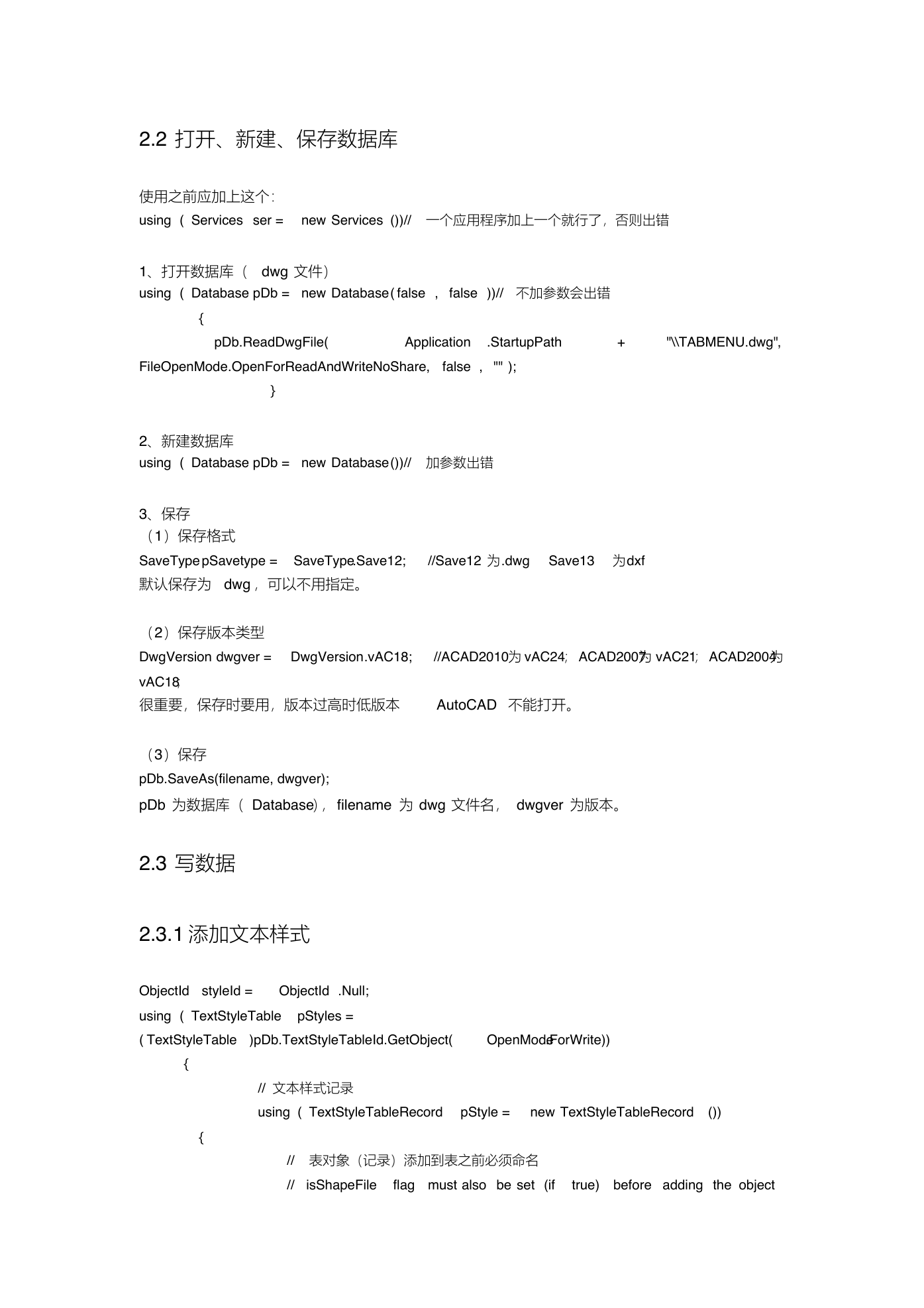
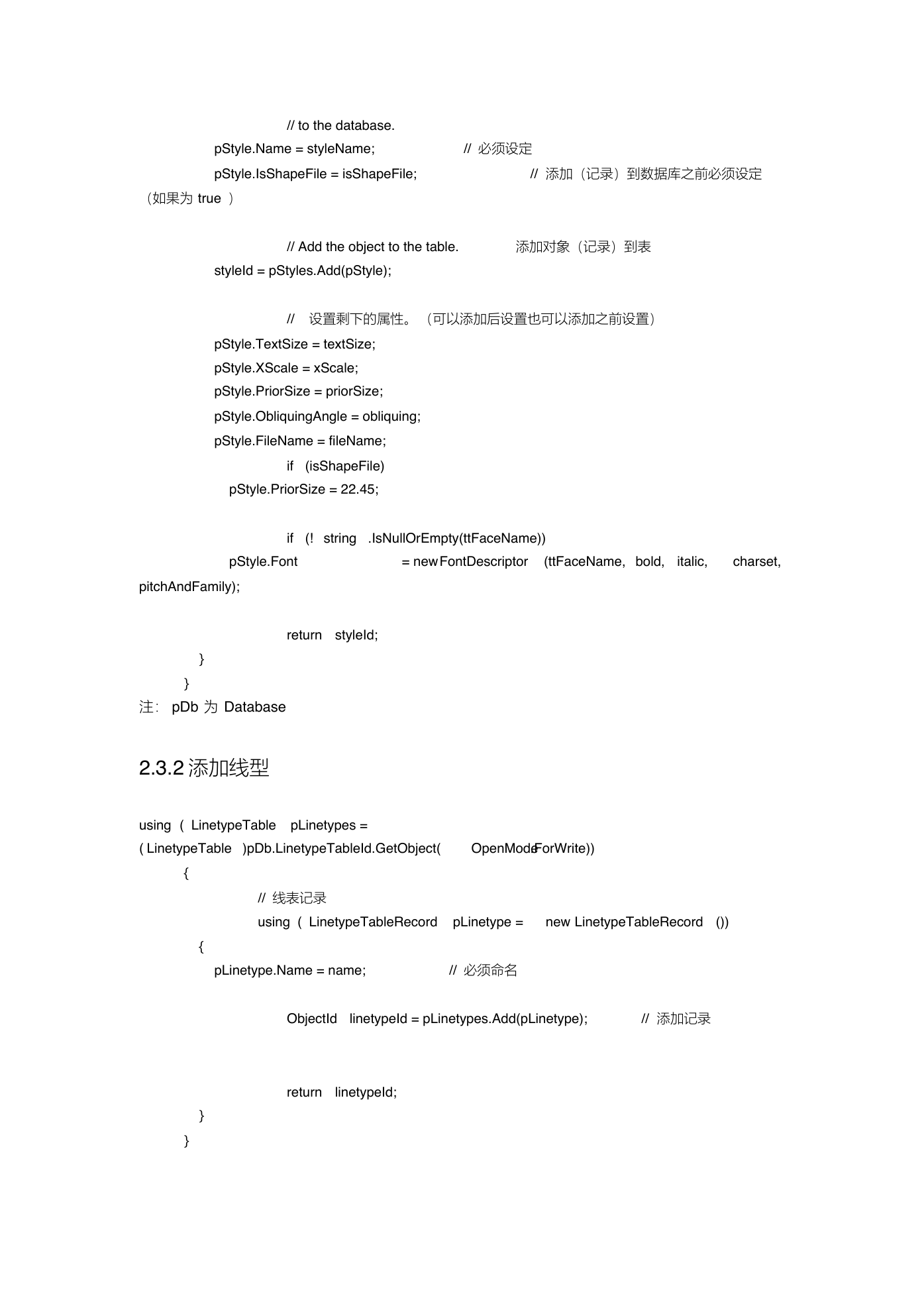
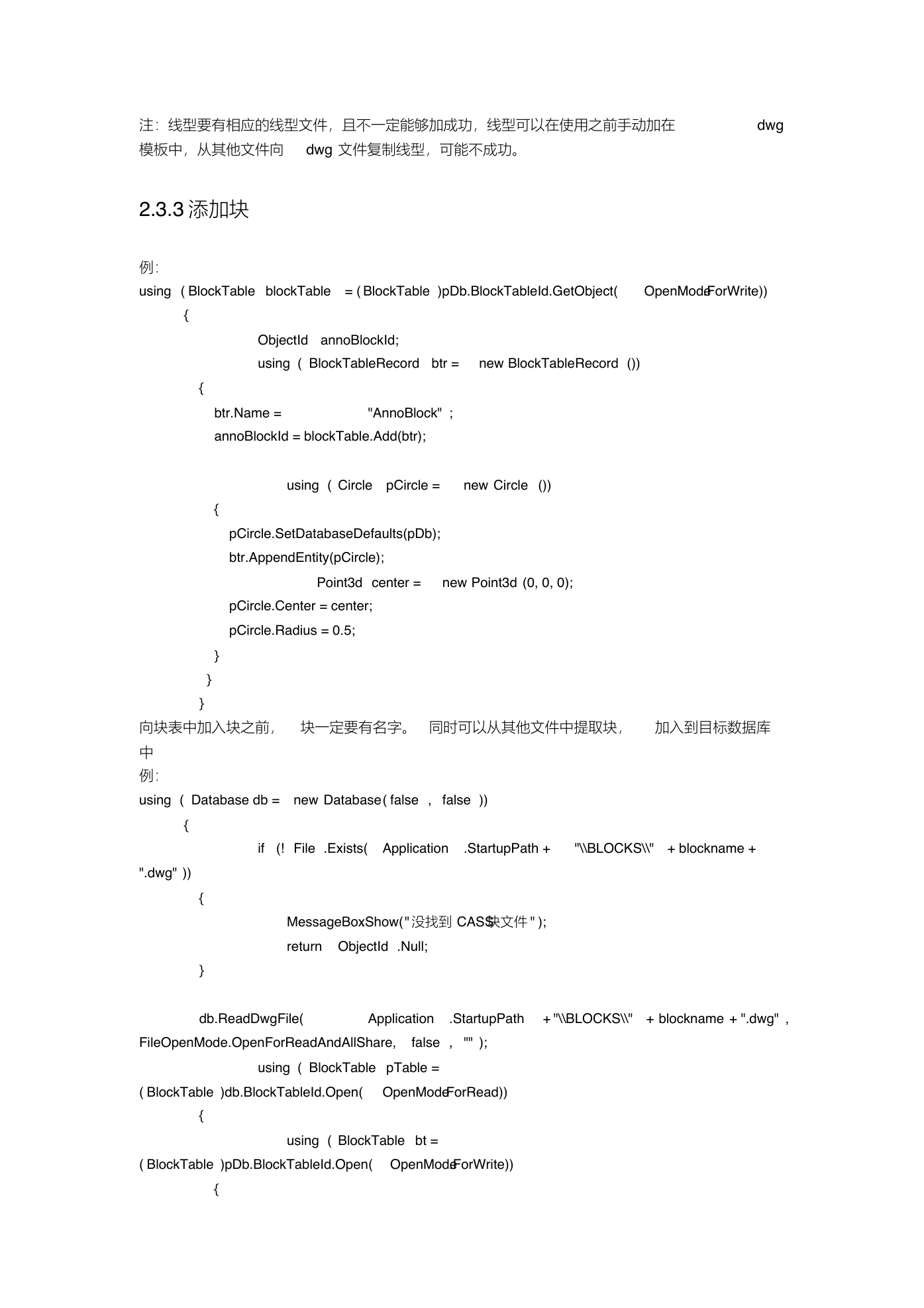
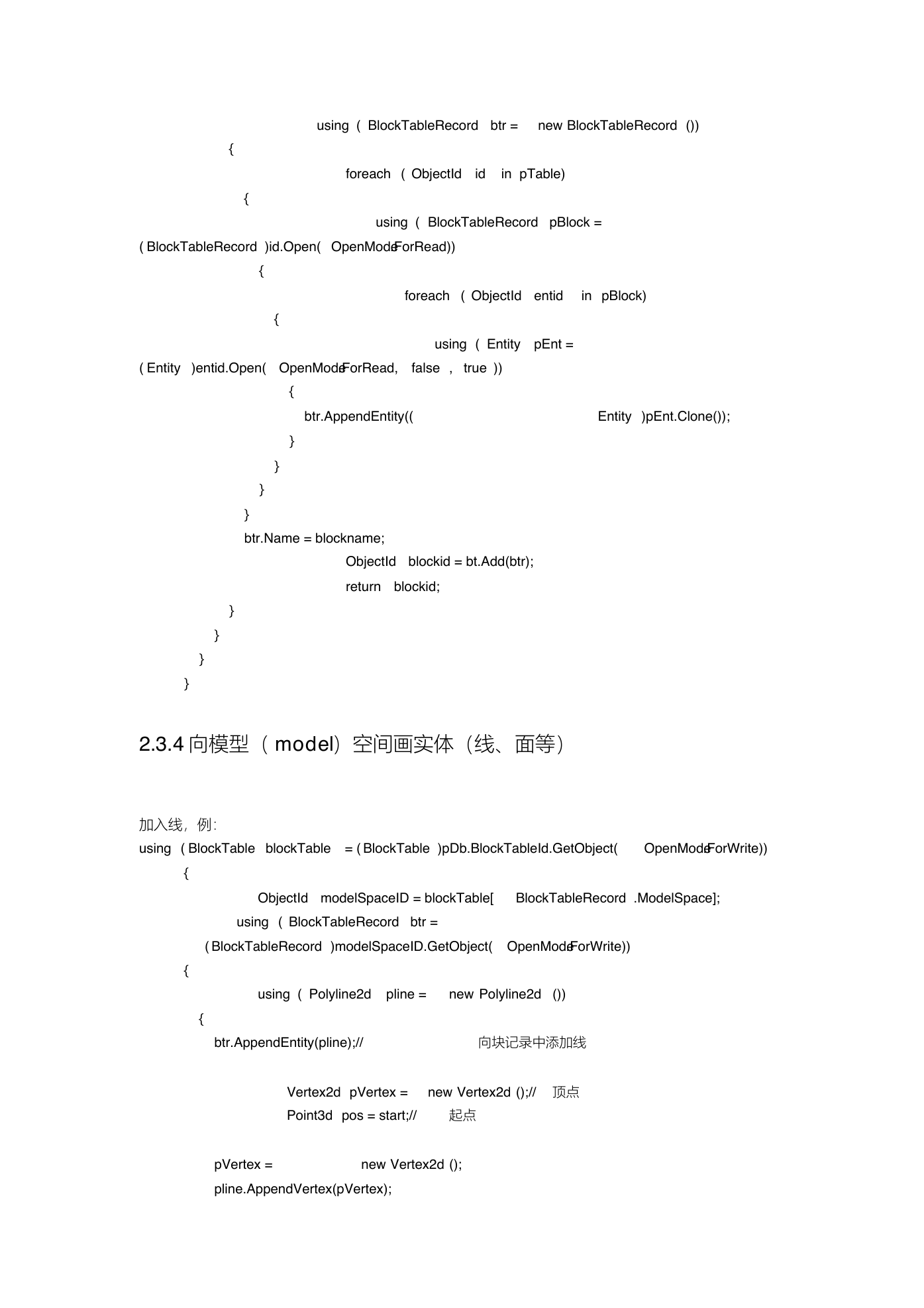
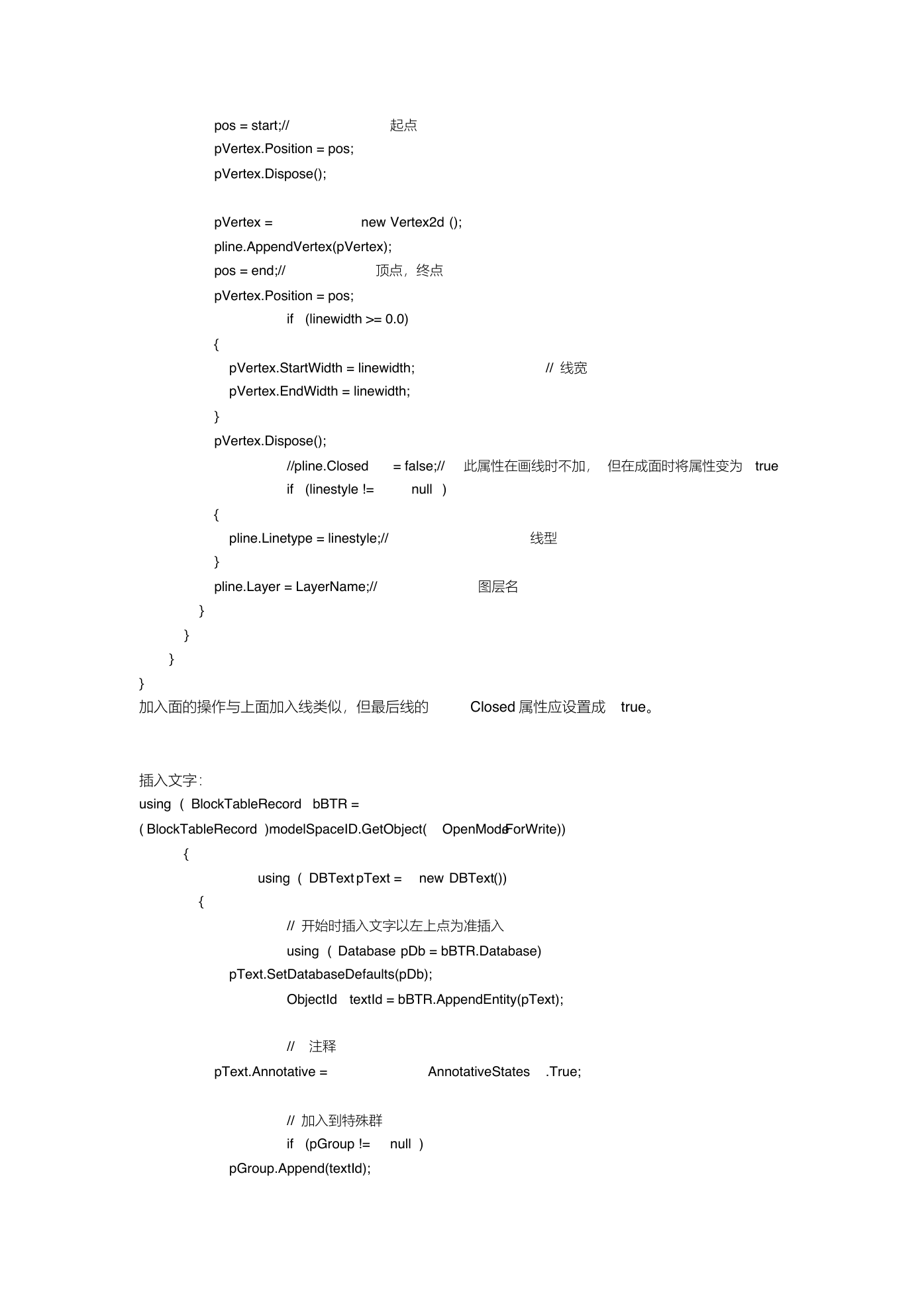
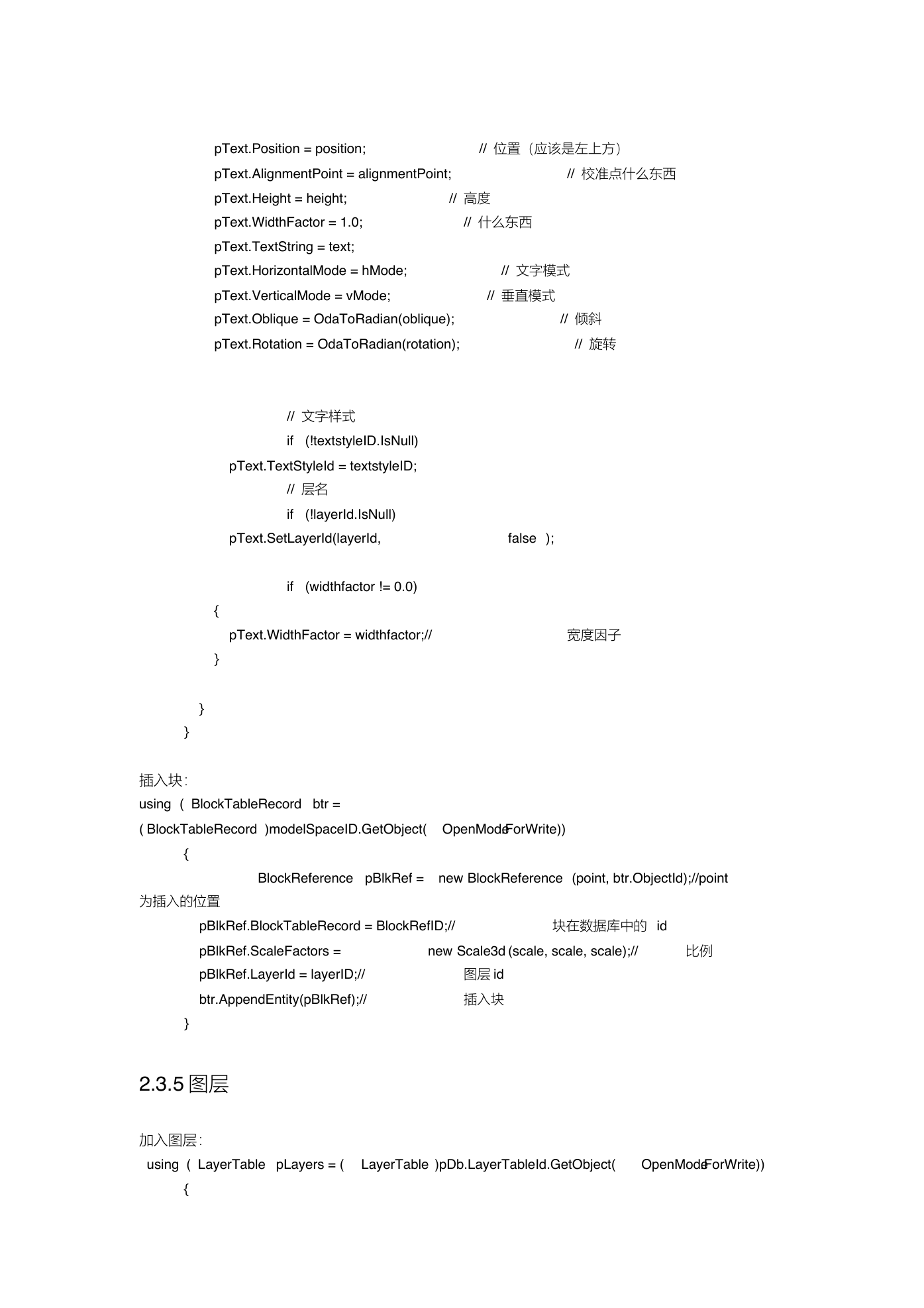
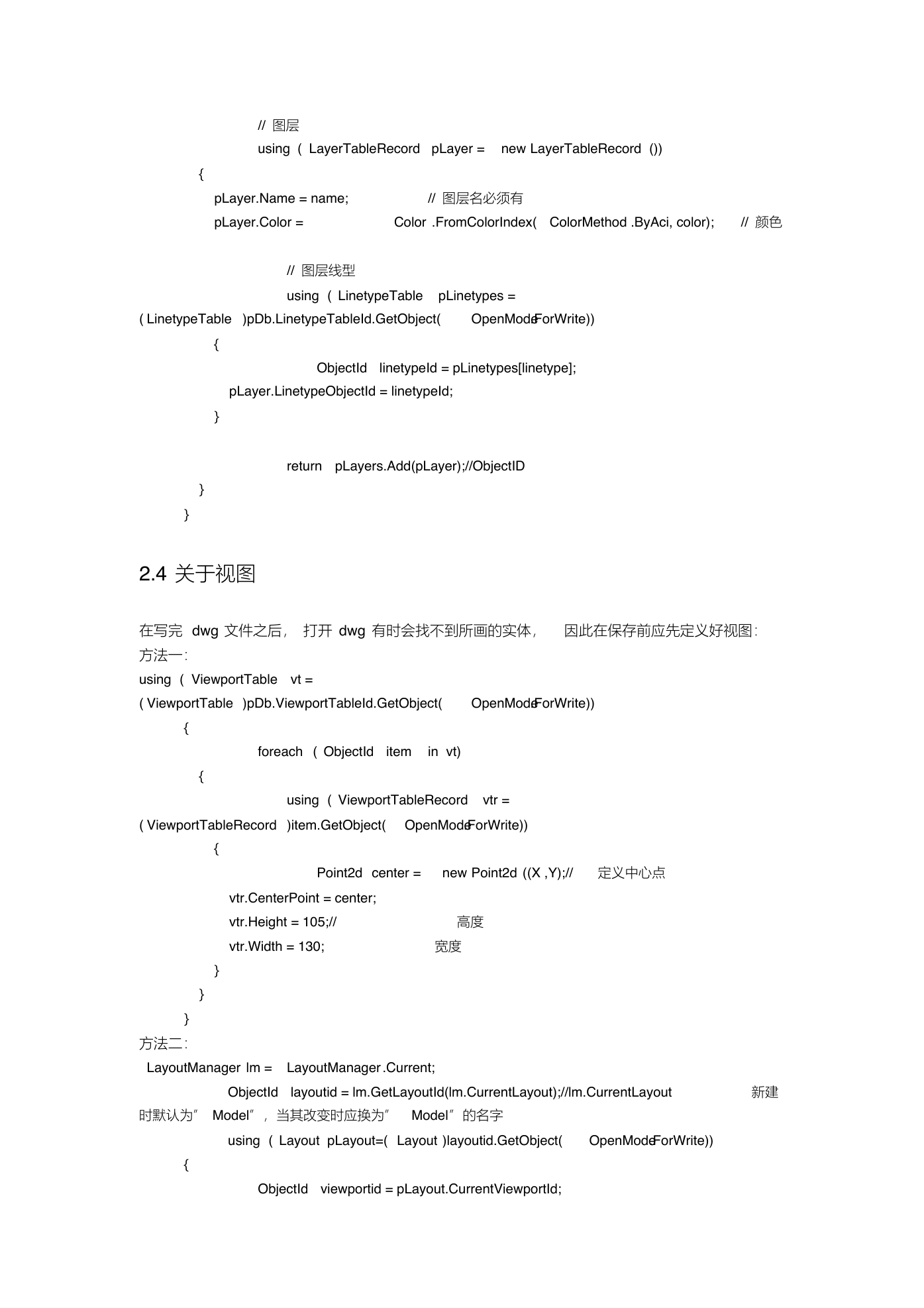








 2023年江西萍乡中考道德与法治真题及答案.doc
2023年江西萍乡中考道德与法治真题及答案.doc 2012年重庆南川中考生物真题及答案.doc
2012年重庆南川中考生物真题及答案.doc 2013年江西师范大学地理学综合及文艺理论基础考研真题.doc
2013年江西师范大学地理学综合及文艺理论基础考研真题.doc 2020年四川甘孜小升初语文真题及答案I卷.doc
2020年四川甘孜小升初语文真题及答案I卷.doc 2020年注册岩土工程师专业基础考试真题及答案.doc
2020年注册岩土工程师专业基础考试真题及答案.doc 2023-2024学年福建省厦门市九年级上学期数学月考试题及答案.doc
2023-2024学年福建省厦门市九年级上学期数学月考试题及答案.doc 2021-2022学年辽宁省沈阳市大东区九年级上学期语文期末试题及答案.doc
2021-2022学年辽宁省沈阳市大东区九年级上学期语文期末试题及答案.doc 2022-2023学年北京东城区初三第一学期物理期末试卷及答案.doc
2022-2023学年北京东城区初三第一学期物理期末试卷及答案.doc 2018上半年江西教师资格初中地理学科知识与教学能力真题及答案.doc
2018上半年江西教师资格初中地理学科知识与教学能力真题及答案.doc 2012年河北国家公务员申论考试真题及答案-省级.doc
2012年河北国家公务员申论考试真题及答案-省级.doc 2020-2021学年江苏省扬州市江都区邵樊片九年级上学期数学第一次质量检测试题及答案.doc
2020-2021学年江苏省扬州市江都区邵樊片九年级上学期数学第一次质量检测试题及答案.doc 2022下半年黑龙江教师资格证中学综合素质真题及答案.doc
2022下半年黑龙江教师资格证中学综合素质真题及答案.doc